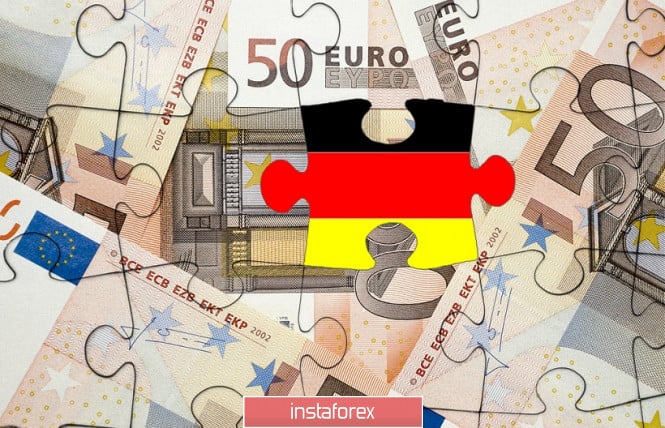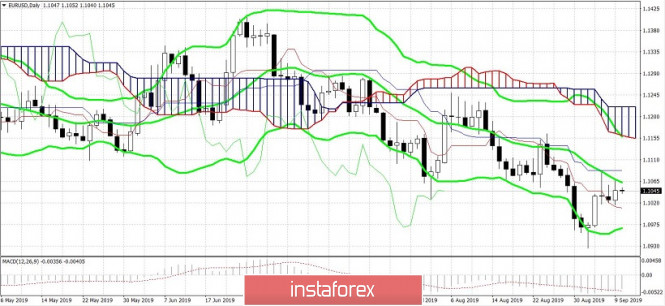The euro-dollar pair moved away from the base of the 10th figure yesterday, reacting to positive news background. Several fundamental factors contributed to the corrective growth of the European currency. At the forefront of events is Germany, which yesterday pleased investors with good statistics and news about the creation of the so-called "shadow budget". After a series of negative macroeconomic reports, traders got the opportunity to win back their lost positions even if the growth of the EUR/USD pair was limited.
Let's start with the statistics. Yesterday, it turned out that export volume unexpectedly increased in Germany. This indicator, taking into account seasonal fluctuations, increased by 0.7% in July compared with June. At the same time, most experts expected a decline in exports by 0.5%. The structure of this indicator suggests that the largest contribution to the growth of the export sector was made by markets outside the European Union. In general, German exports grew by 1% from January to July. Also, the trade surplus rose to 20.2 billion euros in July. Not without a "fly in the ointment" against the backdrop of the growth of German exports, the volume of imports decreased by 1.5%.

Traders of the EUR/USD pair yesterday drew attention to another indicator - the Sentix investor confidence index. This is a leading indicator of economic health, which is formed on the basis of a survey of investors and analysts. For three months (from June to August), it was below the zero mark and consistently decreased, collapsing at the end of the summer to the level of -13.7 points. Contrary to negative forecasts, the indicator recovered slightly to -11 points in September, mainly due to the growth of optimism regarding the trade deal between the USA and China.
However, the main driver of the EUR/USD corrective growth was the news that Germany could create the so-called "shadow budget" to increase government spending. It is worth mentioning right away that this news is unofficial in nature. According to Reuters, the German government is now only considering the possibility of creating this mechanism given the slowdown in the growth of the national economy (German GDP fell by 0.1% in April-June after growing by 0.4% in January-March). The main objective of the mechanism under discussion is to increase government spending in such a way as to circumvent restrictions on the growth of public debt, thereby observing the rules of the European "Stability and Growth Pact."
Let me remind you that for the violation of the Pact, Brussels was going to hold Italy accountable at the end of last year. Rome was facing a fine of several billion euros for exceeding the "ceiling" of the budget deficit. If Berlin succeeds in creating a "shadow mechanism" that will allow legally increasing government spending, then these funds will be directed to infrastructure and other projects. Such prospects were positively received by investors, although Germany officially denies the existence of such intentions. Just last week, a spokeswoman for the German ministry of finance said the government still held the position of "fiscal rationality."
That is why this fundamental factor had a limited effect on the pair. The price rose by several dozens of points but did not even test the 11th figure. Although in my opinion, there is a certain reason for optimism in this case. Let me remind you that even in early August, representatives of the German government said that Berlin could allow a budget deficit by loosening budget-saving rules and abandoning a zero-deficit policy. This assumption was made by Angela Merkel while allowing fiscal stimulation. This position of the chancellor surprised traders as the Germans were always very conservative in this matter.
It is worth noting here that the German Constitution limits the increase in federal debt to 0.35% of the nominal volume of economic production, subject to GDP growth. However, the law provides the government with certain agility in crisis situations. After much debate and debate, Berlin nevertheless expressed its readiness for action and this fact then provided some support for the euro because the financial impulse from Germany is especially important in the context of the September meeting of the ECB. According to some experts, this step on the part of the Germans will allow members of the European regulator not to resort to extremely aggressive measures to soften the parameters of monetary policy. And so, a few weeks later similar information appears on the market again but this time in the context of creating a "shadow budget".

In general, the euro-dollar pair is unlikely to show strong volatility in the coming days, ahead of the September meeting of the ECB, which will be held on Thursday. Among traders, the most diverse rumors are circulating regarding the further steps of the European regulator. Most experts are confident that the Central Bank will not only resume QE but also reduce the interest rate further into the negative area. At the same time, you can increasingly find information in the press that not all members of the regulator agree with the implementation of this scenario. Rumors of a possible split in the ECB camp keep the euro from falling on the eve of the September meeting. Thus, we can assume that in the next two days, the pair will be trading in the range between 1,1005 (Tenkan-sen line on the daily chart) and 1,1090 (Kijun-sen line on the same timeframe).
The material has been provided by InstaForex Company - www.instaforex.com